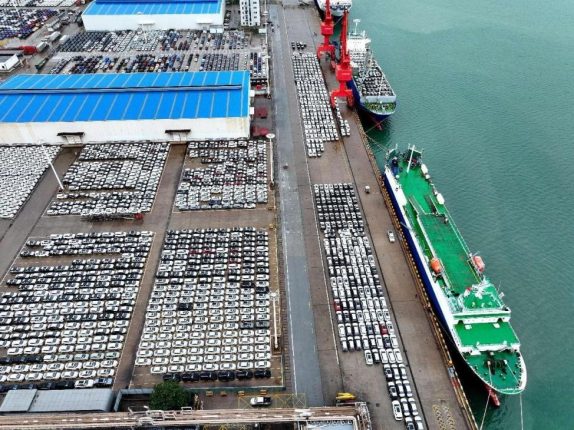CHINESE COASTAL PORTS: NEW ACHIEVEMENTS IN GLOBAL TRADE AND INNOVATIVE ADVANCES

More than 80% of global trade is conducted via maritime transport, which is a vital artery for global goods trade. According to the «Analytical Report on the Operations of Chinese Ports for 2024» (hereinafter referred to as the Report), recently published by the Institute of Transport Planning and Research of the Ministry of Transport of the People’s Republic of China, in 2023, China accounted for 30.1% of the total volume of global trade conducted by sea. This figure represents an increase of 2.2 percentage points compared to the previous year. Due to factors such as the revitalization of foreign trade and the restructuring of the global trading system, the volume of maritime cargo transport for China’s foreign trade has rapidly increased. The cargo throughput of the country’s coastal ports reached 4.96 billion tons, marking a 9.6% increase year-on-year.
Containers, coal, metallic ores, construction materials, and petroleum products are the five main categories of cargo at China’s coastal ports. In 2023, the cargo throughput for these goods constituted 84% of the total cargo throughput at coastal ports. Notably, the throughput for imported coal and crude oil increased significantly, while the throughput for imported iron ore remained high.
Alongside the rapid growth in volume, the structure of maritime cargo transport for foreign trade is also constantly being optimized. In 2023, the share of container transport in the volume of maritime cargo transport for China’s foreign trade reached 23.3%, up by 0.2 percentage points from the previous year and continuing a trend of annual growth. Today, thanks to ongoing improvements in customs services at major Chinese coastal ports, cross-border container cargo transport is becoming increasingly convenient, including small goods from Yiwu (Zhejiang Province, Southeast China), UEFA Euro 2024 merchandise, and electric vehicles.
At Yiwu Port, customs has opened a special window for UEFA Euro 2024. The customs clearance process is implemented on a «one-click» principle, with the vast majority of export goods being checked by computer and released «instantly.» Intelligent equipment installed at Yiwu’s West Station allows for automatic acceptance and inspection of containers without opening them. At Ningbo-Zhoushan Port, Ningbo Customs uses blockchain technology for data storage and cargo tracking, improving the efficiency of customs clearance for bulk cargo. This has enabled the efficiency of loading containers with electric vehicles to increase from 180 units to more than 1,000 per day.
If maritime transport is the «main artery» of China’s foreign trade, then ports are the crucial organs connecting this «artery. » At the Zhichao Port in Shandong Province (East China), a railway stretches westward, passing through the Alashankou checkpoint in Xinjiang (Northwest China) and Kazakhstan, then through Russia, Belarus, Poland, and Germany, reaching the port of Rotterdam in the Netherlands. The total length of this route is over 10,000 kilometers. Recently, Zhichao Port received permission to conduct international combined transit cargo transport. This means that goods transported by sea to Zhichao Port from around the world can now be directly shipped from there by rail to Mongolia, Russia, North Korea, Vietnam, and Central Asian countries.
Cargo throughput is rapidly growing at key coastal ports in China, including ports in the Bohai Bay, Yangtze and Pearl River Delta regions, and the Gulf of Tonkin. The annual increase in cargo throughput at several ports exceeds 10%.
According to the Report, in 2023, China had 23 coastal ports with an annual cargo throughput of over 200 million tons. Leading among them is the Ningbo-Zhoushan Port with a throughput of 1.32 billion tons.
The impressive cargo throughput reflects the continually improving maritime navigation system in China’s coastal ports. The country has created the largest maritime safety assurance mechanism in the world. According to the Ministry of Transport of the People’s Republic of China, from 2013 to 2023, the number of coastal navigation marks in China increased by 68.8%, reaching 20,600. All are equipped with remote measurement and management functions based on the Beidou satellite navigation system. There has been a transition to full use of electronic nautical charts, which are published online and updated in real-time. In 2023, 4.92 million electronic nautical charts of coastal areas in China were released.
Simultaneously, China has built a coastal ground-based Beidou signal enhancement system, covering 23 satellite tracking stations and 75 continuously operating base stations. This system provides navigation with centimeter-level accuracy. A maritime secure communication network has been created as part of the Global Maritime Distress and Safety System. The country is also actively implementing 4G/5G and satellite communication technologies, continuously increasing the capacity of the satellite broadband communication system.
According to the Report’s forecast, there will be continued steady growth in cargo throughput at China’s coastal ports and the volume of maritime cargo transport for foreign trade. It is expected that in 2024, the cargo throughput for foreign trade at the country’s coastal ports will reach approximately 5.1 billion tons, with an annual growth rate of about 3.2%.
Li Qing, Deputy Director of the Research Institute of Water Transport at the Ministry of Transport of the People’s Republic of China, believes that in the long term, the adoption of technologies such as artificial intelligence, 5G, and big data in maritime ports and shipping needs to be accelerated. This will help create intensive and efficient port hubs, facilitate digital, intelligent, and eco-friendly modernization of coastal ports, and enhance their overall capacity.
Source: Online Newspaper «People’s Daily»
